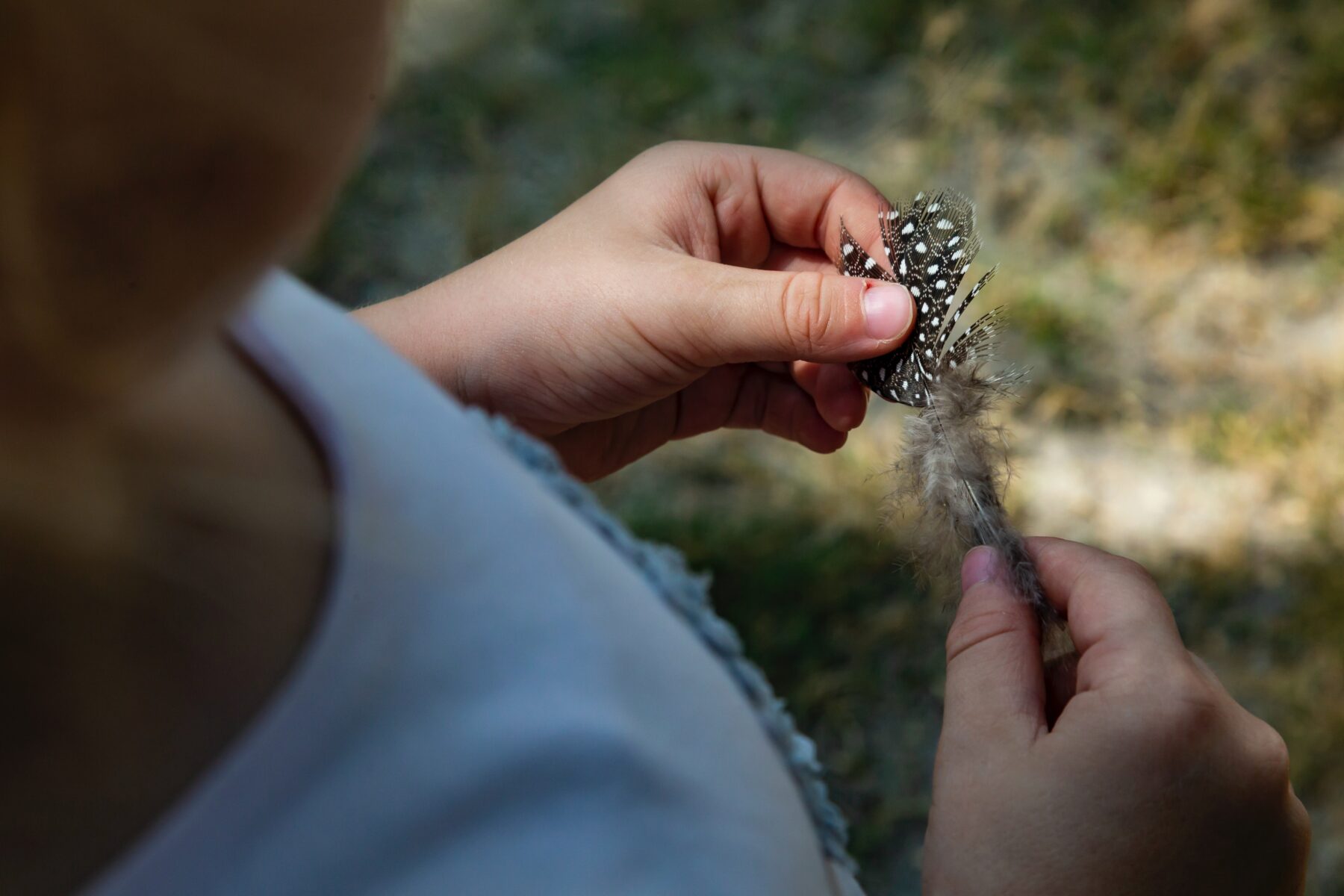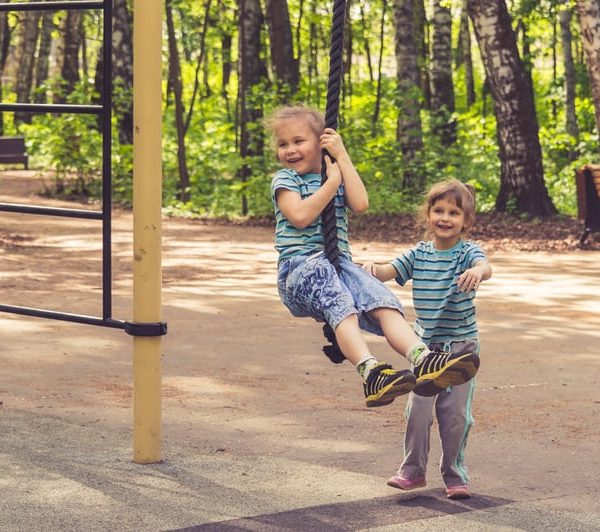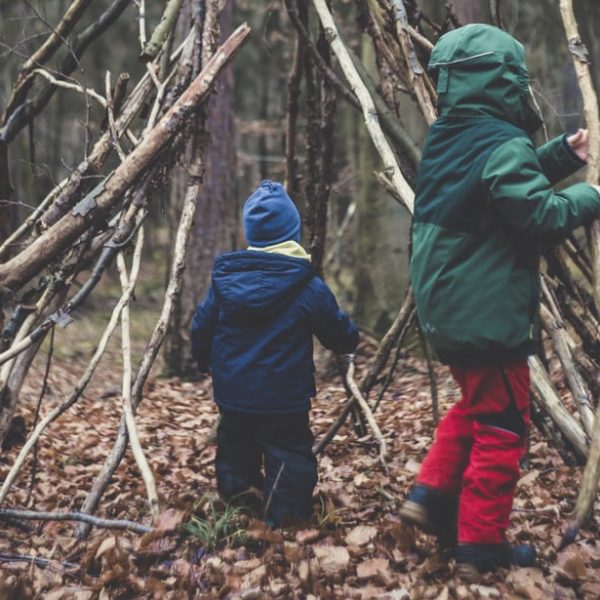Outdoor play ideas for rain or shine

While we’re about to leave the coldest time of year behind us, unpredictable spring showers can still make outdoor programming at children’s services tricky. But whatever the weather, being in nature is vital to children’s learning and development. Here, Lucy runs us through her top outdoor play essentials and ideas for any season.
A rainy day is a feast for our senses. The air feels and smells crisper, hard dirt turns into pliable mud and the sandpit becomes wet – perfect for building and sculpting.
In the early morning, droplets of water collect on leaves and flowers and spider webs become silvery glittery nets. The rain sounds instrumental as it percusses on surfaces. Surfaces get wet and slippery, making climbing more challenging. The natural world behaves differently.
You might be thinking, children will get cold, wet or dirty outdoors. But there’s no such thing as bad weather, just bad clothing! Encourage children (and communicate to families) to dress appropriately for exploring the outdoor world – this means wearing warm, waterproof clothes that are OK to get dirty.
Make sure you have spare wet weather gear on hand (especially at outside school hours care services where children may be wearing a school uniform). Think gumboots, jackets, raincoats and gardening gloves. You could ask families for donations or try your local hardware store.
Now that the children are equipped for any weather, let’s head outdoors! I truly believe that any inside activity can be brought outside. Here are some of my favourite outdoor play ideas.
Lucy’s top outdoor play ideas
Make your own clay. Did you know that if you soak dirt in water, the clay will separate from the soil? It’s a free resource! Further, if unfired clay is placed back into water, it will eventually return to its former pliable state.
Set up a weather station. Have the children measure rainfall, wind and temperature. If you have a garden, you could also measure plant growth. What can the children hypothesise from weather patterns? What did the Bureau of Meteorology (BOM) predict for that particular day? Was BOM correct or did the weather change?
Construct a rain gauge. Choose some plastic containers (water bottles with the tops cut off work well) from the recycle bin to collect rainwater. Add a little beetroot juice or powder paint to the bottom, so children can clearly see the water level. Paint millimetres or centimetres on the side for measurement.
Do some mud painting. Ask everyone to help collect a cup of mud and pour it into a big tub. Tip: Add a squirt of dishwashing detergent to help the mud spread more easily. Stir with sticks or spoons. Use a variety of paintbrushes, like sponges, nail brushes, leaves or fingers. Have children paint different outdoor surfaces with mud, like rocks or trees.
Build your own landscape. Provide access to large blocks, bricks, rocks and other loose parts so the children can build bridges and pathways across muddy puddles, and create their own versions of waterways and river systems.
Get in the garden. August is known as Guling, ‘Orchid Season’, by the Traditional Owners of the land on which we teach, play and learn in Melbourne, the Wurundjeri people of the Kulin Nation. Guling is marked by orchids flowering and silver wattle bursting into colour 1 – and it’s the perfect time to tend to your garden! Research which indigenous Australian plants will flourish in your local climate. You may be able to organise an excursion to a native nursery, to have children choose the plants they would like to grow.
Do some water painting. Fill a bucket with rainwater. Children can paint outdoors on any surface and watch it magically dissolve. Why does it dissolve and disappear?
Start composting and worm farming. To reduce food waste going to landfill and to produce nourishment for your garden soil, your service could start composting or build a worm farm! Worms will do most of the work – just make sure you include brown and green matter, and layer it like a lasagne. Refer to Gardening Australia (abc.net.au/gardening) for simple and sustainable ideas to set up composts and worm farms in your garden.
Play with loose parts. Allow children to play outdoors with whatever loose items you can source to spark creativity. Contact local businesses or ask parents if they have any unwanted items laying around that your service could save from heading to landfill. Useful items could include cable reels, bits of garden hose, fabric remnants, tarpaulins, crates, containers, saucepans or wooden planks. If you’re having trouble sourcing loose parts, you could purchase items from Resource Rescue.
Go on a bug safari. See how many different kinds of bugs can be found in your outdoor environment. What are they doing? What is their role? What relationships do they have with the trees or other things in your garden?
Design a nature scavenger hunt. Ask children to go around your outdoor space to identify natural items, such as plants, animals, soil, rocks, etc. Then, collate their findings into a nature scavenger hunt specific to your service. Check out this gorgeous example from Eco Explorers Australia.
Play nature bingo. List several verbs or descriptive words, like slimy, rough, brown, soft, crunchy, etc. Then, ask the children to find an example in nature. Ask them to describe what they find.
Make some nature art. Go look on the ground for fallen sticks, seeds pods and leaves. Be careful as sometimes these are homes for insects. Create a group or individual nature collage with the found items.
BONUS: Outdoor play ideas beyond your service fence
Plan a walking excursion. Who needs a bus? Walk to a local park, bush reserve or waterway. You could even pick up rubbish as you walk. Remember to discuss with the children that there are certain items they cannot touch as they may be dangerous. Of course, you must first undertake a risk assessment, available via ACECQA.
Take an alphabetical nature walk. As you walk, see if the children can identify items for each letter of the alphabet.
Build nature cubbies. At your local bush reserve, collect dry sticks from the ground and discuss how these could be used to create a nature cubby. After designing and building the scaffolding, you might like to find other branches with leaves for the roofing. How can you attach these together? Again, consider that natural items may house small animals and insects and ask children not to disturb them, as these items are their homes.
The information shared here was first published in Roundtable magazine, and has been reshared with permission.
Popular

Practice
Provider
Quality
Research
Workforce
New activity booklet supports everyday conversations to keep children safe
2025-07-10 09:00:16
by Fiona Alston

Quality
Practice
Provider
Workforce
Reclaiming Joy: Why connection, curiosity and care still matter in early childhood education
2025-07-09 10:00:07
by Fiona Alston

Policy
Practice
Provider
Quality
Research
Workforce
Beyond the headlines: celebrating educators and the power of positive relationships in early learning
2025-07-07 10:00:24
by Fiona Alston













